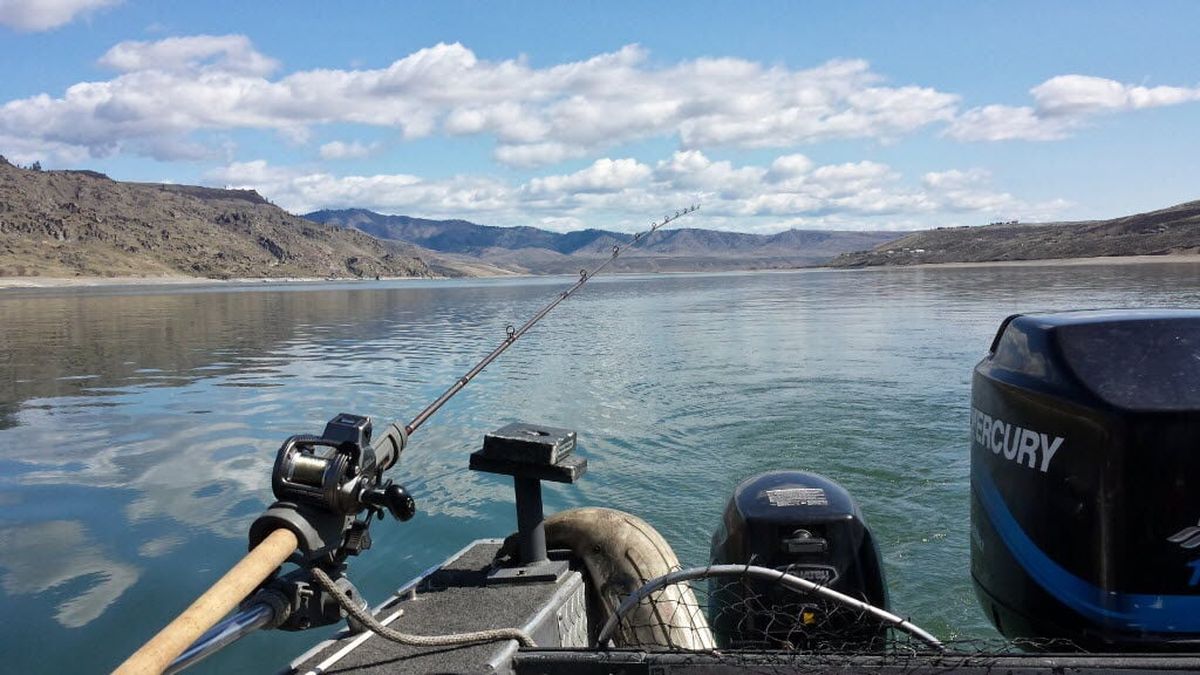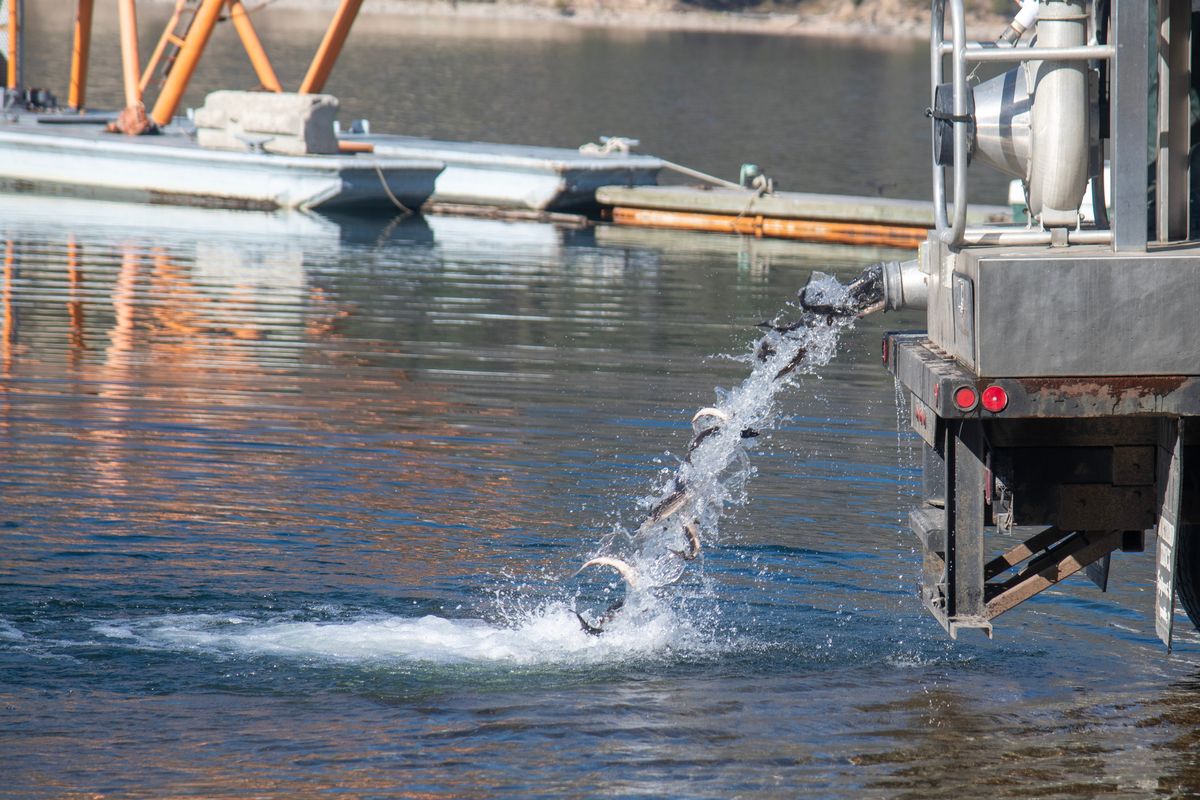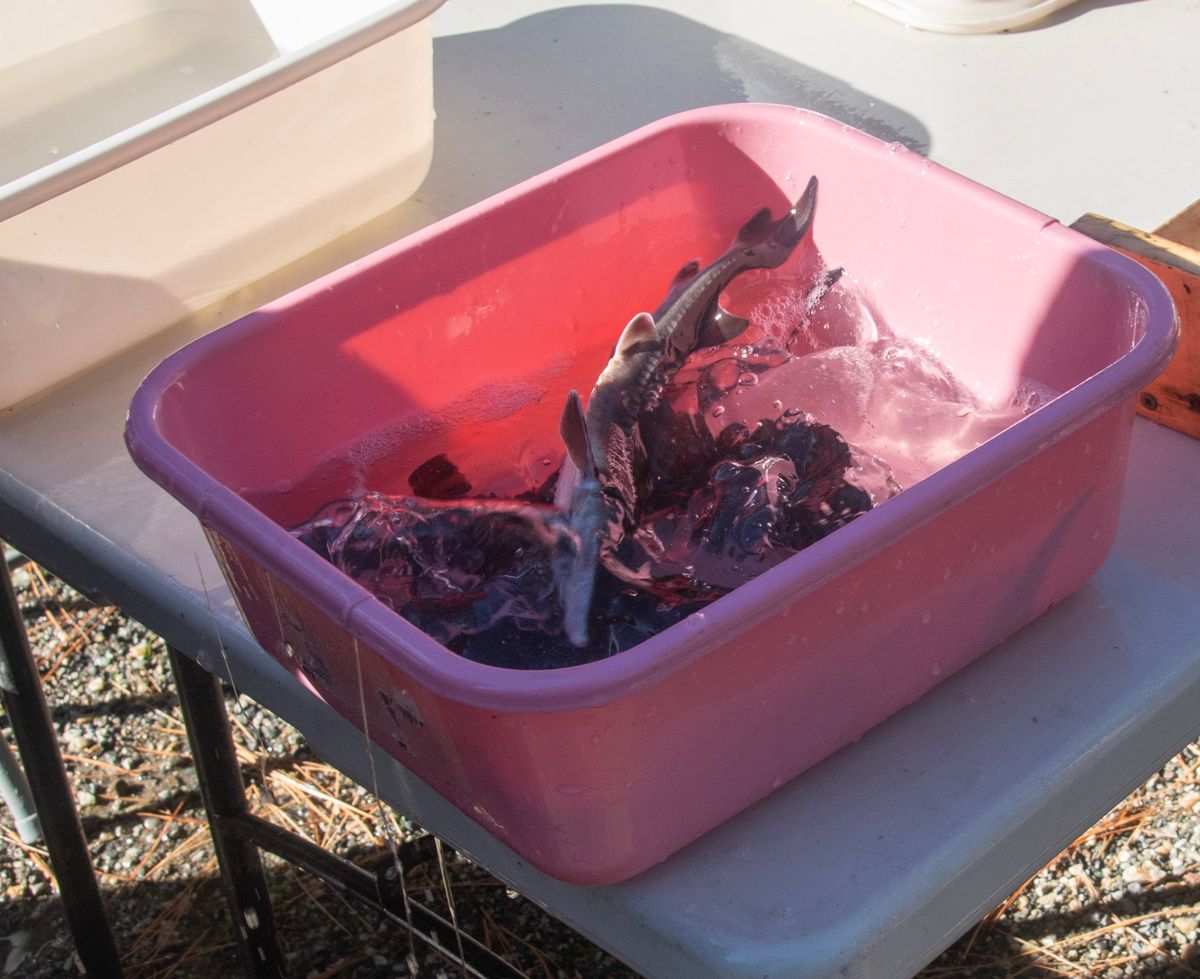Saving sturgeon: How a hatchery program revived the white sturgeon population in Lake Roosevelt
Sturgeon tumble out of a Washington Department of Fish and Wildlife tanker into Lake Roosevelt near Kettle Falls Oct. 18, 2023. (Michael Wright/THE SPOKESMAN-REVIEW)
KETTLE FALLS, Wash. – Standing at one end of a folding table, Derick Largin handled a small white sturgeon carefully, checking its back for a tag. Then he measured it, from snout to tail.
He called out the number and handed the fish to the person next to him, who weighed it. One person logged the data on a computer. Another took DNA samples from some of the fish – small fin clips.
When the fish reached the end of the makeshift assembly line in the parking lot of the Sherman Creek Hatchery, it was placed in a bucket, where it would wait until it was time to be loaded into a hatchery truck and eventually dumped into Lake Roosevelt.
“These guys are like 17 months old,” Largin said, handling another fish.
That means for the past 17 months, he’s been watching them grow, from small larvae to the size of a decent trout. Once they reach a target weight – close to half a pound – they’re ready to go into the lake.
That sunny day in October, Largin and staffers from WDFW, the Spokane Tribe and the Confederated Tribes of the Colville Reservation were making the final preparations before releasing the fish. By the end of two days, they’d handled about 3,700 fish, all of them now swimming somewhere in the lake.
The operation is part of a long-running program between the tribes and WDFW that has breathed life back into Lake Roosevelt’s sturgeon population. For decades, the species has been unable to repopulate itself without help. Adult fish can spawn, but their offspring don’t live for more than a few weeks. That created a big problem: Once all the adults died, there would be no sturgeon left.
Since the early 2000s, the state and the tribes have worked together to raise sturgeon at hatcheries and place them in the lake, as have officials in Canada. It has been so successful that in 2017, WDFW began allowing anglers to target the fish, and even take them home. It was the first time in more than two decades that anglers could harvest the fish.
The agency is still keeping a close eye on the lake’s sturgeon, though, and still raising more sturgeon every year. It has tweaked the season dates and the size of fish anglers are allowed to harvest, trying to focus the impacts from angling on the age classes of sturgeon that can handle the most pressure. At the end of this decade, WDFW expects to switch to a catch-and-release only season.
Todd Graves, owner of Lake Roosevelt Charters, said the rule changes have made it more challenging to find “keeper” fish, and shifting season dates have come with a learning curve. He also said an eventual catch-and-release season is likely to hurt his business.
He understands the reasoning, though, and the alternative.
“If it wasn’t for those guys, we wouldn’t be catching them at all,” Graves said.
Recruitment woes
White sturgeon are the largest freshwater fish in North America. They look prehistoric, with bony, dinosaur-esque scales called scutes, and they get huge – some grow longer than 10 feet, and they can reach 1,000 pounds. They have a lifespan similar to a human’s, and it’s possible for the fish to live as long as a century.
Sturgeon are native to the Columbia River drainage, and they’re found in a number of places along the upper Columbia River, including Lake Roosevelt, the reservoir formed by Grand Coulee Dam.
Beginning in the 1970s, biologists began noticing that Lake Roosevelt’s sturgeon were not living to adulthood. Called “recruitment failure,” the issue was apparent in Canada and in Washington. As a result, each sturgeon that died left a hole in the population that wasn’t getting filled with another fish. In 1998, WDFW estimated there were 3,400 adults left in the population.
“What we ended up with was sort of an aging adult population with very few fish filling in behind,” said Bill Baker, a biologist with the Washington Department of Fish and Wildlife.
Jason McLellan, a biologist for the Confederated Tribes of the Colville Reservation, said young sturgeon are hatching from their eggs and becoming larvae, which disperse and hide while feeding on their yolk sac. A couple of weeks later, they transition to a fish’s normal fare – macroinvertebrates.
Somewhere in that transition, the fish start disappearing. The larval stage is the last time biologists can regularly find them, McLellan said.
“We’ve been looking for 20-plus years for juvenile recruits,” said McLellan, who started his sturgeon work as a biologist for WDFW in the early 2000s. “We catch very, very few.”
A collaborative group of scientists from the U.S. and Canada has been trying to figure out why.
Hypotheses abound. There’s a long legacy of industrial pollution in the upper Columbia, and studies have shown that metals and slag-contaminated sediments can impact sturgeon shortly after they hatch. Lake Roosevelt is also full of predators like bass and walleye that eat young fish. The construction of the dams on the upper Columbia reconfigured streamflows, perhaps impacting where the sturgeon larvae disperse to after hatching in late spring and early summer, when natural streamflow would be highest.
But no one factor has been proven to be the culprit. The only way to help the fish persist was to help them reach adulthood, and officials knew how to do that – raise them in hatcheries.
To get sturgeon eggs that would still have wild genes, biologists caught wild adult sturgeon and brought them to a hatchery. After the adults spawned, they were returned to the lake and the eggs were raised until they were big enough to be released, typically a year or more.
From 2003 on, the U.S. program released roughly 4,000 fish a year, and Canada released more than 10,000 in most years, according to a graph prepared by WDFW.
Once they were back in the lake, the fish did well. Biologists talk about survival rates of 90% or more. McLellan said it was even better than they expected.
The success came with a drawback. Bringing adult sturgeon to spawn in a hatchery meant they were drawing genetics from only a few members of the population. Releasing their offspring back into the wild risked reducing the genetic diversity of sturgeon in the lake, swamping the population with the genes from just a few wild fish. Over time, that would increase the chances that the population would have inbreeding problems.
McLellan and others working on the issue at the time came up with a different plan. By that point, they knew sturgeon in the lake were spawning naturally, and they knew where. Instead of bringing full-sized sturgeon to a hatchery – a cumbersome and somewhat dangerous task – they decided to try catching newly hatched larvae and raising them in the hatchery instead.
Catching thousands of larvae throughout the spawning season would ensure the fish they raise have many different parents, and broader genetic diversity.
The tribes and WDFW switched to that method permanently in 2011. Now, each June and July, staffers from the tribes and WDFW go out on the lake at night and drop nets deep into the water. When they pull the nets up, they use a turkey baster to separate sturgeon larvae from everything else they’ve caught, and the larvae end up in barrels in a room at the hatchery.
Back to the lake
WDFW prohibited anglers from harvesting sturgeon in Lake Roosevelt in 1995. Seven years later, the catch-and-release season ended.
The hope driving the recovery efforts beyond avoiding extinction was surely that one day, a fishing season might return.
That day came in 2017. A season was set, and harvest limits: Anglers could take home two sturgeon a year, and the fish needed to be between 38 and 63 inches long.
People loved it. Anglers flocked to the lake, catching thousands of sturgeon. Since 2017, anglers have taken home roughly 5,000 sturgeon.
It also brought them to the small towns near the lake, like Kettle Falls and Colville. Andy Dunau, executive director of the Lake Roosevelt Forum, said it gave the region an economic boost.
“That fishery has done wonderful things for the local communities and their economies now that people are allowed to have a season,” Dunau said.
Graves, who had started Lake Roosevelt Charters in Hunters a couple of years earlier, said the announcement of a sturgeon season surprised him. Until then, he’d mostly been taking anglers out to catch walleye and trout, and the occasional kokanee.
Sturgeon were something different to chase – a big fish, and relatively rare table fare. Since then he’s become good at finding them.
He’s caught them at a variety of depths, from 20 feet down to 250 feet. He also said they’re being caught throughout the lake, even down by Seven Bays.
“There’s no shortage of sturgeon,” Graves said.
But opening the fishery wasn’t a set-and-forget situation. Managers are still watching the fish closely, and they’ve made adjustments every couple of years to protect the most vulnerable fish in the population.
The size range that anglers can keep – called a slot limit – has been tightened, now at 53 to 63 inches. This year, WDFW shifted the season to the fall to ease pressure on the remaining wild fish. Many of those fish are too big to keep, but they still get caught. The stress from catching and releasing a fish can still kill it, and having that stress when water temperatures are high increases that risk.
“We want the fishery to continue, but we want to minimize whatever impact we’re having,” said Brian Walker, a biologist for WDFW.
More changes are coming, too. In a presentation earlier this year, WDFW officials laid out the agency’s plans through 2031. In 2025, he expects to tighten the slot limit to 55 to 63 inches. In 2027, it would go to 57 to 63 inches. The move is meant to protect fish of a certain age and focus angler harvest on the age classes that can lose the most members and still persist.
In 2029, WDFW expects to move to a catch-and-release only season for at least two years. Officials believe there won’t be enough fish of catchable length to let people kill them. A catch-and-keep season could return after that based on stock assessments.
Graves said those changes will result in fewer people taking trips to chase sturgeon in the lake. Locals may like catching and releasing fish, but the anglers who travel to the lake and hire someone like him want to bring some meat home.
“It’s a tough pill to swallow, but it is what it is,” Graves said. “It’s going to affect the economy.”
Meanwhile, the work at the hatchery is going to continue. With no fix for recruitment failure, it’s the only way they can ensure the lake’s sturgeon population doesn’t backslide. The United States’ recovery goal is 5,000 sturgeon by 2080, and the hatchery program is going to play a crucial role in meeting it.
So every June and July, there will be boats out at night, catching sturgeon larvae. When there are enough fish big enough to go back to the lake, assembly lines will form again in the hatchery parking lot, readying the fish for release.
In October, after about 1,000 fish had been loaded into the truck, it pulled out and drove across the bridge at Kettle Falls. It took a dirt road past a lumber yard and backed down a boat ramp.
The tanks were opened, and water gushed out, carrying the fish into the lake.
When the truck was empty, it drove away. The young white sturgeon finned around in shallow water near the ramp, rediscovering their home.








